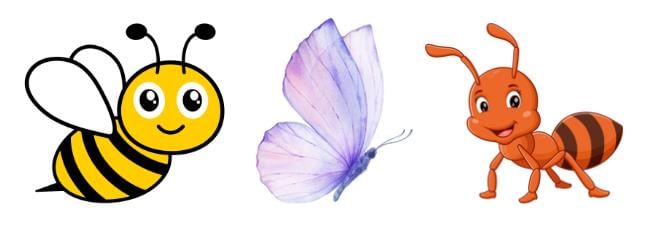Short Answer Questions: Animals | EVS for Class 2 PDF Download
Q1. What are animals?
Ans: Animals are living things that can move, eat food, and sometimes make sounds. They come in many shapes and sizes, from tiny insects to big whales.
 Animals
Animals
Q2. What are some examples of large animals?
Ans: Large animals include elephants, whales, giraffes, and rhinos. They can be very tall or heavy.
Q3. Can you name some medium-sized animals?
Ans: Medium animals are bigger than tiny creatures but smaller than large animals. Examples are cats, rabbits, and foxes.
Q4. What are tiny animals?
Ans: Tiny animals are very small creatures like ants, bees, butterflies, and mice. Sometimes you need a magnifying glass to see them well.
 Tiny Animals
Tiny Animals
Q5. What are domestic animals?
Ans: Domestic animals live with humans and are often pets or help with work. Dogs, cats, and parrots are examples.
Q6. What are wild animals?
Ans: Wild animals live freely in forests or jungles and are not usually kept as pets. Lions, tigers, and elephants are wild animals.
Q7. Who are farm animals?
Ans: Farm animals live on farms and help people by providing food or doing work. Examples include cows, goats, and hens.
Q8. What are aquatic animals?
Ans: Aquatic animals live in water all their lives. They breathe using gills. Examples are whales, sharks, dolphins, fish, and octopuses.
 Aquatic Animals
Aquatic Animals
Q9. What makes birds special?
Ans: Birds have feathers, wings, two legs, and a beak. Most can fly, and some are good swimmers. Sparrows, crows, and pigeons are birds.
Q10. What are insects?
Ans: Insects are small animals with six legs and sometimes wings. Examples include ladybirds, cockroaches, houseflies, butterflies, and grasshoppers.
 Insects
Insects
Q11. What do herbivorous animals eat?
Ans: Herbivores eat grass and plants. Cows, buffaloes, goats, deer, giraffes, donkeys, and elephants are herbivores.
Q12. What do carnivorous animals eat?
Ans: Carnivores eat only the flesh of other animals. Lions, tigers, leopards, hawks, and some whales are carnivores.
Q13. What do omnivorous animals eat?
Ans: Omnivores eat both plants and meat. Examples include crows, bears, jackals, and gorillas.
Q14. Why are animals important for nature?
Ans: Animals help keep the environment balanced by eating different foods and living in various places.
Q15. How can animals be classified based on where they live?
Ans: Animals can be domestic (living with people), wild (living in forests), farm (living on farms), aquatic (living in water), or birds and insects.
|
30 videos|304 docs|48 tests
|
FAQs on Short Answer Questions: Animals - EVS for Class 2
| 1. What are the most common types of animals kept as pets? |  |
| 2. How can I choose the right pet for my lifestyle? |  |
| 3. What are the basic needs of a pet animal? |  |
| 4. What should I do if my pet shows signs of illness? |  |
| 5. How can I help my pet adjust to a new home? |  |
















